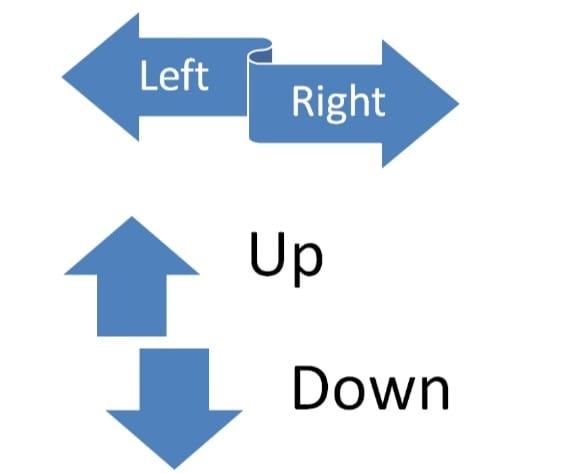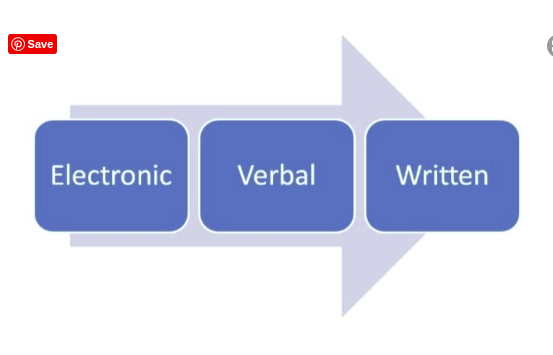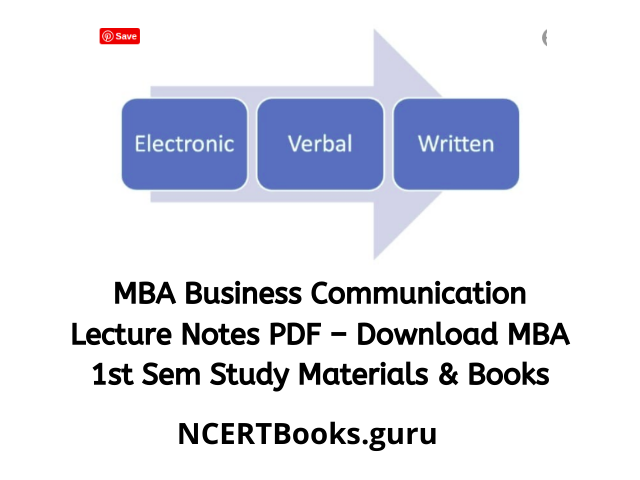Business communication is a key aspect of managing the human resources of the company in the internal environment and clients and stakeholders on the external aspect. Communicating effectively across the length and breadth of the hierarchy is important for running the organization successfully. Bigger the company, the complex is the business communication across the levels.
The various directions of a company’s communication movements are:

What does this mean?
- Left- This communication direction is along the lines of employees with equal pay grade but different functional teams. The information traveled is a reversal in nature.
- Right- This communication direction is also among the line of employees with equal pay grade but different functional teams. The information traveled here is forward in nature.
- Up- This is an essential direction of communication in a company. The communication is bottomed up. This means employees are communicating with the managers and people above their pay grade. This ensures a healthy employee engagement in a company.
- Down- This form of communication direction is seen in almost all companies. It’s called trickle-down communication strategy. People with higher pay grad pass information and orders to employees with lower pay grade. This is a monologue communication strategy.
Also, check the following links:
Various reasons why Business communication is important in a business entity:
- Employee inclusion- A proper communication strategy both upwards and downwards in the hierarchical system helps develops good employee engagement in the company.
- Eliminates inefficiency- Useless team meetings, miscommunications, and unnecessary and frequent client interactions reduce work efficiency among the workforce. Proper status reports, crisp and brief presentations, graphs, and plots for proper understanding are effective communication strategies than long haul reports and presentations.
- Eliminates information bottlenecks: There is something called as information silos in business meetings. This point refers to the crux of the meeting. In this, we use the 80-20 rule where 80% of the importance of the actual useful communication comes from 20% of the overall communication. Irrelevant content communication causes information silos.
- Employee productivity: Effective internal communication, especially for those employees who are new to the industry, helps them cope with abruptness and readiness in case of sudden challenges. Information overload causes fatigue and confusion among the workforce. Time spent on communicating information must be 10 times less than the time spent on working on the content communicated. This is called good and effective business communication
- Improvement in cross-functional and intra and interdepartmental communications- One of the herculean tasks that HRs and managers face is to synchronize the work culture and synergy of different departments in the company and different teams within a department. A feeling of co-dependence and inclusion amongst various departments like production, HR, marketing, finance, etc., should be developed so that the whole company is working in the same direction and for the same goal.
- Reduces employee turnover- Attracting and keeping the millennial or the odyssey workforce as it is called requires essential inclusion and employee engagement. This is most likely achieved when there is effective two-way communication. A monologue of hierarchy, with a trickle-down communication from top to bottom, decreases employee engagement and efficiency and motivation of the workforce.
These are the business communication needs along the lines of the internal environment of a company.
Let’s discuss some points regarding the importance of business communication with respect to the external environment:
- Customer satisfaction and retention- If a company needs to develop a sense of trust and reliability among the consumer market, they need to effectively communicate what their business stands for and how the corporate governance is taken care of. Because today’s consumers have an affinity towards the work ethic and social responsibilities of companies. This generation is more attracted towards a sustainable, environmental, and societal friendly business model.
- Employees at the line of visibility, where they directly interact with the customers should have enough information about the business and its various aspects so as to give crystal clear clarity for the consumer queries.
- Eliminates bull-whip or whiplash effect- Proper communication between manufacturers, retailer, and distributors help reduces blurring information through different channels. Bullwhip effect leads to over and under burdening of inventories across the supply chain leading to loss of economy of scale both for retailers as well as manufacturers. There are various ways to eliminate this effect using proper business communication strategies.
- Sales forecast and reliability- Salespeople are the frontline warriors in any business. They are the point of contact between the consumer market and manufacturing units. Proper communication is of utmost importance at this junction.
- Increase brand awareness- Weaving stories around your product or service and developing an emotional and psychological connection with your consumer leads to brand loyalty. This brand loyalty tagged with strong influencing power of consumers and word-of-mouth marketing leads to strong brand recall value. With proper communication channels and use of Integrated media Communication (IMC) across various platforms, both digital and offline, can create a good impact on the brand and hence increase the sales revenue.
Three essential forms of business communication followed everywhere are:

The electronic or online form of communication- This form of communication is no longer of secondary priority. Most of the tech-savvy companies have adopted online form communication as primary over verbal or written. It offers various advantages, like :
- Speed of communication
- Work from home options for employees
- Involve as many people as you want.
- Hidden and open agendas for meetings and gatherings.
There are plenty of advanced online communication platforms like Zoom or Clickmeeting which have been gradually taking over conventional forms of online communication like mail or SMS.
Verbal: While it’s the oldest form of communication, but is still a highly popular and undoubtedly a reliable form of communication for companies across industries. This includes:
- Live meetings
- Face to face interviews
- Group discussions
- Personal task assignments
While it is time-consuming and requires the physical presence of the workforce, many companies at the top level prefer this form of communication to maintain privacy and eliminate chances of digital snooping and hacking. Sensitive issues and meetings are best communicated in this form.
Written- Frequently used form of communication when concise, precision, and detail is a priority. Sales and manufacturing reports, official memos, etc., are all written on a piece of paper. This keeps the employees engaged and helps them understand better about the tasks at hand. This is still used in companies that haven’t upgraded their technological infrastructure. Many governmental organizations still resort to this type of communication across all functional levels.
What does it take to be a good business communicator at an individual level?
- Extempore and impromptu- One of the best examples of this skill is the marketing guru of the world, Apple founder and former CEO Steve Jobs. His signature blend of communication has inspired a generation of business leaders.
- Attitude and clarity of mind.
- Pleasant attire and body language.
- Well versed in written and spoken language (Preferably English) etc.,
Business communication is not only important for the students of MBA to get placed and do well in the corporate world, but is also important for their own personality improvement and developing people skills.
B-Schools line XLRI, TISS, IIM-B offer highly concise and flagship programs to improve business communication skills of their students. Because at the end of the day, an excellent orator and communicator has the ability to become the next big business leader in the world, as evidenced by leaders like Steve Jobs or Mark Zuckerberg
MBA Business Communication Lecture Notes PDF
“Communication is something so simple and difficult that we can never put it in simple words,” says T.S. Mathews. But we do need a definition to understand the term. In his book Communication in Business, Peter Little defines communication as follows: “Communication is the process by which information is transmitted between individuals and/or organizations so that an understanding response results.”
| Business Communication Notes free download | Download Links |
| complete business communication notes | Download |
| Business Communication Text Book Pdf | Download |
| MBA Business Communication Question Paper Pdf | Download |
MBA Business Communication Textbooks PDF
- Pal, Rajendra, and Korlahalli, J. S., Essentials of Business Communication.
- Fred Luthans, Organizational Behaviour, Boston, McGraw-Hill, 8th edition, 1998.
- Kaul, Asha, Effective Business Communication.
- Lesikar, Raymond V., and Pettit John D, Business Communication: Theory and application, 6th edition, Richard D Irwin publication.
- Sharma, R. C., Business Communication, and Report Writing.
- Varinder Kumar, Raj Bodh, Business Communication, Kalyani Publishers, New Delhi, 2001.
- Lesikar, R. V., and Pettite J. D., Business Communication.
- Sharma, R. C., Business Communication, and Report Writing.
- Sinha, P., Business Communication.
- Business Communication by K. K. Sinha. Galgotia Publishing Company., New Delhi.
- Business Communication by C. C. Pattensheti. R. Chand and Company Publishers., New Delhi.
- Essentials of Business Communication by Rajindra Pal and J. S. Korlahalli. Sultan Chand and Sons., New Delhi.16
- Effective Business Communication by Herta A. Murphy and Charles E. Peck. Tata McGraw Hill Publishing Company Limited., New Delhi.
- Essentials of Business Communication by Pettett and Lesikar. Tata McGraw Hill Publishing Company Limited., New Delhi.
- Business Communication by Pettett and Lesikar. Tata McGraw Hill Publishing Company Limited., New Delhi.
MBA Bussines Communication Syllabus for MBA 1st semester
Lesson: 1
INTRODUCTION TO COMMUNICATION
Objective: The main objective of this lesson is to make the students learn on the subject matter of business communication vis-à-vis its nature and importance.
Structure: Introduction, The Concept of Communication, Significance of Communication, Nature of Business Communications: A Case Study
Lesson: 2
Effective Communication Skills
Objective: The major objective of this lesson is to create an understanding of the minds of students regarding various communication skills and also let them know the relevance of such skills.
Structure: Introduction, Objective of Business Communication. Effective Communications Skills, Summary, Key Words.
Lesson: 3
PROCESS OF COMMUNICATION
Objective: The foremost objective of this lesson is to generate thoughtful ideas in the psyche of students as regards the process of communication and the sequencing of different steps that the process of communication contains.
Structure: Introduction, How to Understand Communication Process, A Common Misconception, The Communication Environment, A Well Designed Communication Process, Summary, Key Words.
Lesson: 4
BARRIERS AND GATEWAYS TO COMMUNICATION
Objective: The primary objective of this lesson is to breed the attentive thoughts in the consciousness of students relating to barriers and gateways in business communication and to enable them to avoid the occurrence of such events in communication that create a communication gap.
Structure: Introduction, Barriers in Communication., Gateways to Communication Barriers, Making Communication Effective, Summary, Key Words, Self Assessment Questions, Suggested Readings.
Lesson: 5
COMMERCIAL LETTERS
Objective: This lesson educates the students on how to communicate clearly and effectively through commercial letters. It explains the basic skills necessary to write various types of commercial or business letters.
Structure: Introduction, Do’s and Don’t of Commercial Letter
Lesson: 6
BUSINESS REPORTS WRITING
Objective: The primary objective of this lesson is to make the students learn the basics of business reports and make them understand how effective reports are written.
Structure: Introduction, Types of Business Reports, Characteristics of A Good Report, Structures of Business Reports
Lesson: 7
ORAL AND NON-VERBAL COMMUNICATION
Objective: The main objective of this lesson is to make the students learn the basics of Oral and Non-verbal Communication.
Structure: Introduction, Oral and Non-verbal Communication
Lesson: 8
PUBLIC SPEAKING AND PRESENTATION
Objective: The primary objective of this lesson is to make the students learn about the basics of public speaking aspects in business communication and to enable them to avoid the occurrence of such events in public speaking that do not add to the value of the speaker.
Structure: Introduction, Encoding and Translating, Understanding Your Audience, Targeting Your Audience, Designing a Presentation, Preparing the Venue and Seating Arrangement, Final Point and Getting Start
Lesson: 9
COMMUNICATION: NEGOTIATIONS AND LEGAL ASPECTS
Objective: The most important objective of this lesson is to make the students learn the basics of business negotiation skills in
communication along with its legal aspects.
Structure: Introduction, Phases of a Negotiation, Characteristics of a Negotiation, Opening Negotiations, Legal Aspects of Communication
Lesson: 10
AGENCY CORRESPONDENCE IN BUSINESS
Objective: The objective of this lesson is to give the learners an understanding of agency correspondence, thereby enabling them to draft various agency related letters.
Structure: Introduction, Essentials of Agency Correspondence, Hints for Drafting Agency-related Letters, Some Sample Letters
MBA Business Communication Review Questions
- Communication is sharing of understanding”, Discuss this and bring out the process of communication.
- “Management is a two-way traffic; it is based upon the effective machinery of communication.” Discuss this statement.
- What are the main barriers to organizational communication?
- Discuss the psychological barriers to effective communication.
- How do the personal opinions and prejudices of various individuals act as barriers to effective communication? Illustrate your answer with suitable examples.
- What is meant by status-consciousness? How does it impede the smooth flow of communication?
- Explain how the wrong choice of the channel of communication acts as a barrier to communication.
- How does language act as a barrier to effective communication?
FAQs on Business Communication MBA Books & Notes Pdf
1. What is the best book for business communication?
Here is the list of top 5 Business Communication Textbooks for MBA students. You can refer them from the following list and utilize the book for your exam preparation.
- Sharma, R. C., Business Communication, and Report Writing.
- Varinder Kumar, Raj Bodh, Business Communication, Kalyani Publishers, New Delhi, 2001.
- Lesikar, R. V., and Pettite J. D., Business Communication.
- Sinha, P., Business Communication.
- Business Communication by K. K. Sinha. Galgotia Publishing Company., New Delhi.
2. Where can I get Business Communication Lecture Notes?
You can get the best MBA business communication study materials pdf download links for free of cost along with other preparation resources like question papers, syllabus from our page, or else you can visit your university official website.
3. What are the types of business communications?
The four basic types of business communication are Internal (Upward Communication), Internal (Downward Communication), Internal (Lateral Communication), and External Communication.
4. Can I Download MBA Business Communication Notes & Books in PDF Format?
Yes, you can download Business communication MBA Books & Study Materials in Pdf format form our site. Here, we have provided all MBA lecture notes in pdf download for easy access to students along with some additional resources like subject experts recommended books for scoring better marks in the exam.
